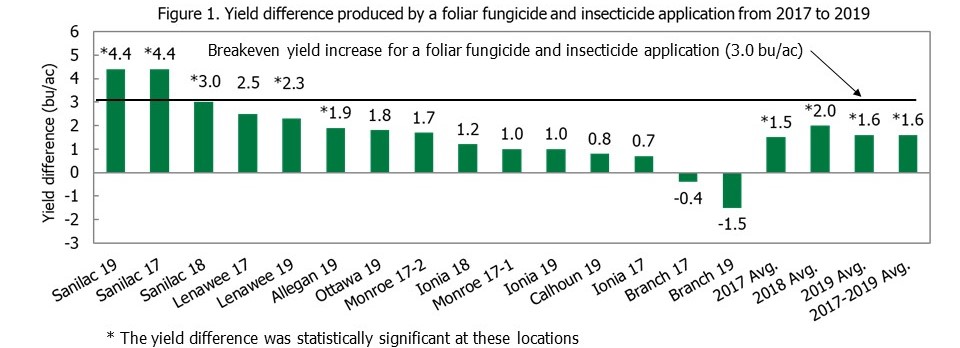Are foliar fungicides plus insecticide tank mixture applications to soybeans profitable?
On-farm research results collected from 2017 to 2019 can help soybean producers decide if they should apply foliar fungicide and insecticide tank mixtures in 2020.

Soybean producers are interested in increasing soybean yields and income by applying foliar tank mixtures of a fungicide and an insecticide. However, extension entomologists do not recommend insurance tank mixes like this for a variety of reasons, unless insects are over threshold. The Michigan soybean on-farm research program coordinated a total of 15 trials from 2017 to 2019 to evaluate the yield and income performance of foliar fungicide and insecticide tank mixtures.
Cooperating producers were given the opportunity to select the foliar fungicides and insecticides they wanted to evaluate on their farms. The products, application rates and rainfall information for each location are listed in table 1. Please note that none of the fungicides included in the trials were rated as good or very good for managing white mold. The foliar applications were made at R3 and the sprayers were driven through the untreated control treatments to prevent tire tracks from being a factor.
|
Table 1. Products, application rates and rainfall information for the trial locations in 2017, 2018 and 2019. |
||||||
|---|---|---|---|---|---|---|
|
Location |
Fungicide - rate |
Insecticide - rate |
*Rainfall totals and hours of rain for July and August |
|||
|
Trial year (inches) |
2016-2019 avg. (inches) |
Trial year (hours) |
2016-2019 avg. (hours) |
|||
|
Sanilac 19 |
Priaxor - 4 oz/ac |
Fastac - 3.8 oz/ac |
4.0 |
6.1 |
47.0 |
65.0 |
|
Sanilac 17 |
Priaxor - 4 oz/ac |
Fastac - 3.8 oz/ac |
4.5 |
6.1 |
68.0 |
65.0 |
|
Sanilac 18 |
Priaxor - 4 oz/ac |
Fastac - 3.8 oz/ac |
5.3 |
6.1 |
72.0 |
65.0 |
|
Lenawee 17 |
Priaxor - 4 oz/ac |
Fastac - 3.8 oz/ac |
3.9 |
6.0 |
52.0 |
59.5 |
|
Lenawee 19 |
Priaxor - 6 oz/ac |
Fastac - 3.8 oz/ac |
7.4 |
6.0 |
69.0 |
59.5 |
|
Allegan 19 |
Delaro – 8 oz/ac |
Leverage – 2.8 oz/ac |
5.5 |
7.8 |
58.0 |
70.0 |
|
Ottawa 19 |
Quadris - 6 oz/ac |
Baythroid XL - 1.5 oz/ac |
5.5 |
6.1 |
60.0 |
64.3 |
|
Monroe 17-2 |
Priaxor - 4 oz/ac |
Fastac - 3.8 oz/ac |
3.9 |
6.0 |
52.0 |
59.5 |
|
Ionia 18 |
Stratego - 6 oz/ac |
Mustang Maxx - 3 oz/ac |
7.7 |
7.7 |
82.0 |
82.5 |
|
Monroe 17-1 |
Priaxor - 4 oz/ac |
Fastac - 3.8 oz/ac |
3.9 |
6.0 |
52.0 |
59.5 |
|
Ionia 19 |
Lucento – 5 oz/ac |
Mustang Maxx - 3 oz/ac |
5.6 |
7.7 |
64.0 |
82.5 |
|
Calhoun 19 |
Miravis Neo -14 oz/ac |
Endigo – 4 oz/ac |
6.3 |
6.8 |
63.0 |
64.8 |
|
Ionia 17 |
Stratego – 6 oz/ac |
Mustang Maxx – 3 oz/ac |
5.3 |
7.7 |
54.0 |
82.5 |
|
Branch 17 |
Priaxor - 4 oz/ac |
Fastac - 3.8 oz/ac |
5.1 |
6.8 |
64.0 |
64.8 |
|
Branch 19 |
Priaxor - 4 oz/ac |
Fastac - 3.8 oz/ac |
6.3 |
6.8 |
63.0 |
64.8 |
*Rainfall data was obtained from the nearest MSU Enviroweather station.
The foliar fungicide-insecticide application significantly increased soybean yields at five of the 15 locations (Figure 1). However, it was profitable at only two locations. When all 15 locations were combined and analyzed, the foliar fungicide and insecticide tank mixture produced an average yield increase of 1.6 bushels per acre, which is just over half the yield increase required to break even. Levels of disease and insect pressure are important for increasing the probability of a profitable response to foliar fungicides and insecticides. This is a probable reason they are not generally that profitable in Michigan, unless we are targeting something like white mold.

It is interesting that the cooperator in Sanilac County produced the three highest yield increases from applying the tank mixture. We have discussed this extensively and the cooperator feels that he is applying the products at the optimum growth stage and providing excellent coverage by using a spray volume of 20 gallons per acre. We have not identified anything else that could be responsible for the consistent yield increases.
The on-farm research results clearly show that prophylactic foliar fungicide and insecticide tank mixtures are rarely profitable. This is probably because we don’t have significant foliar disease pressure in Michigan. Even if foliar diseases are present, it is unlikely in Michigan that there are insects in the field over threshold, so the addition of the insecticide part to the tank mix is wasted money. Unnecessary pesticide applications have other costs, for example driving resistance of pathogens and insects, which makes them more difficult to control in the long term. Unneeded insecticide applications can kill beneficial organisms or increase the risk of honey bee kills and complaints. Due to the low probability of a profitable response and the potential for increasing pest resistance, prophylactic applications of foliar fungicide and insecticide tank mixtures are not recommended.



 Print
Print Email
Email